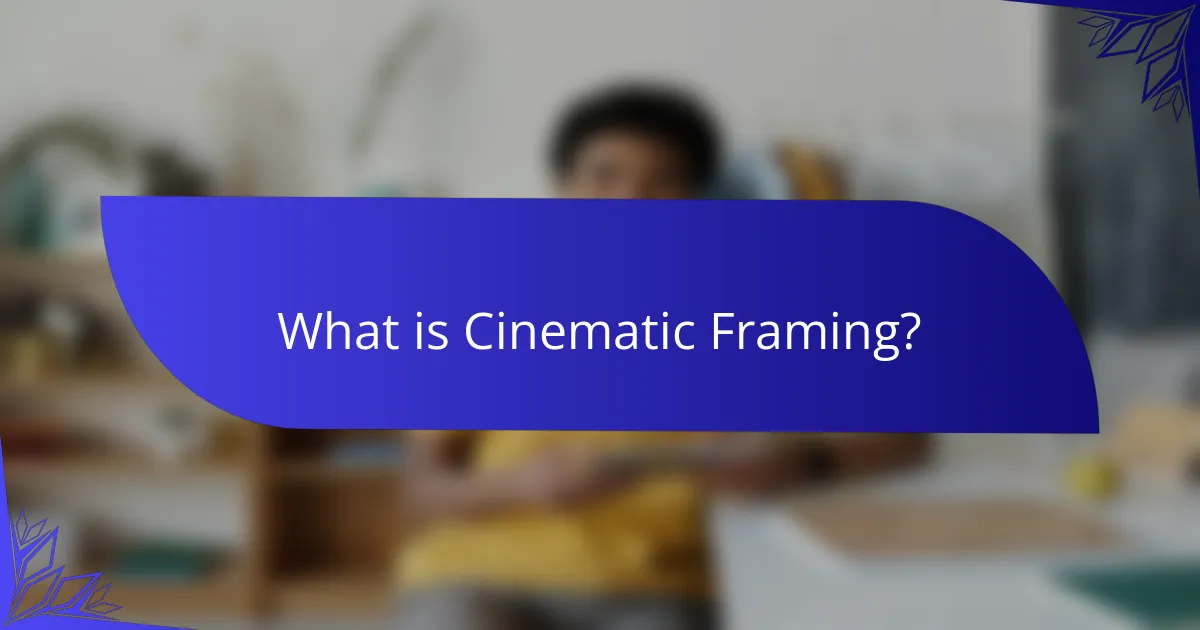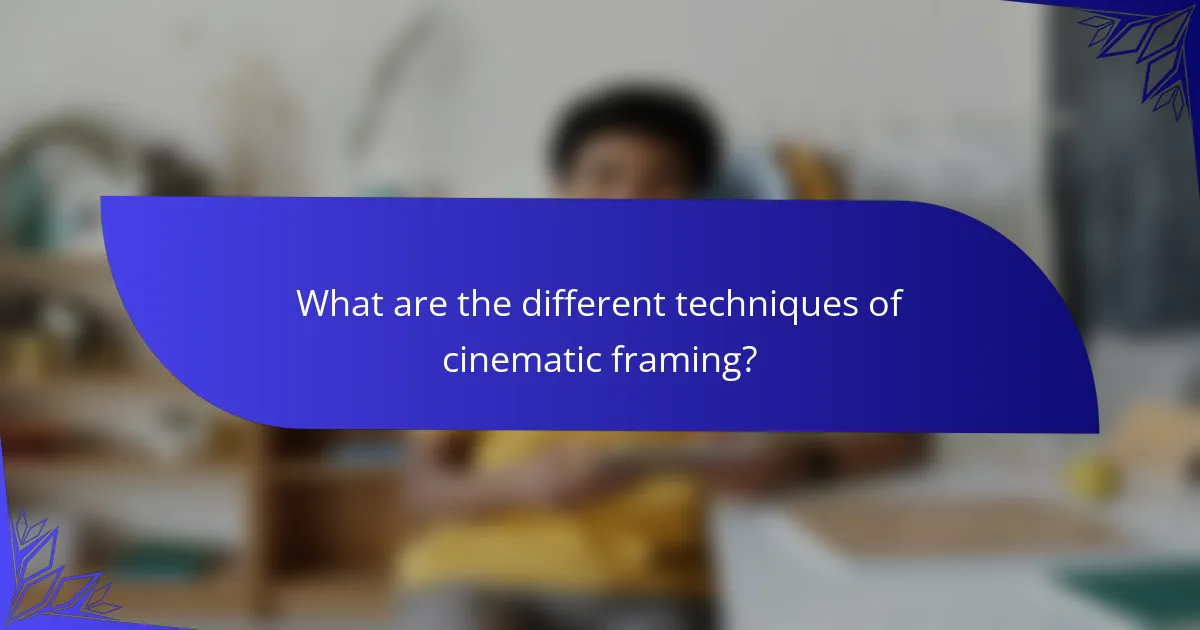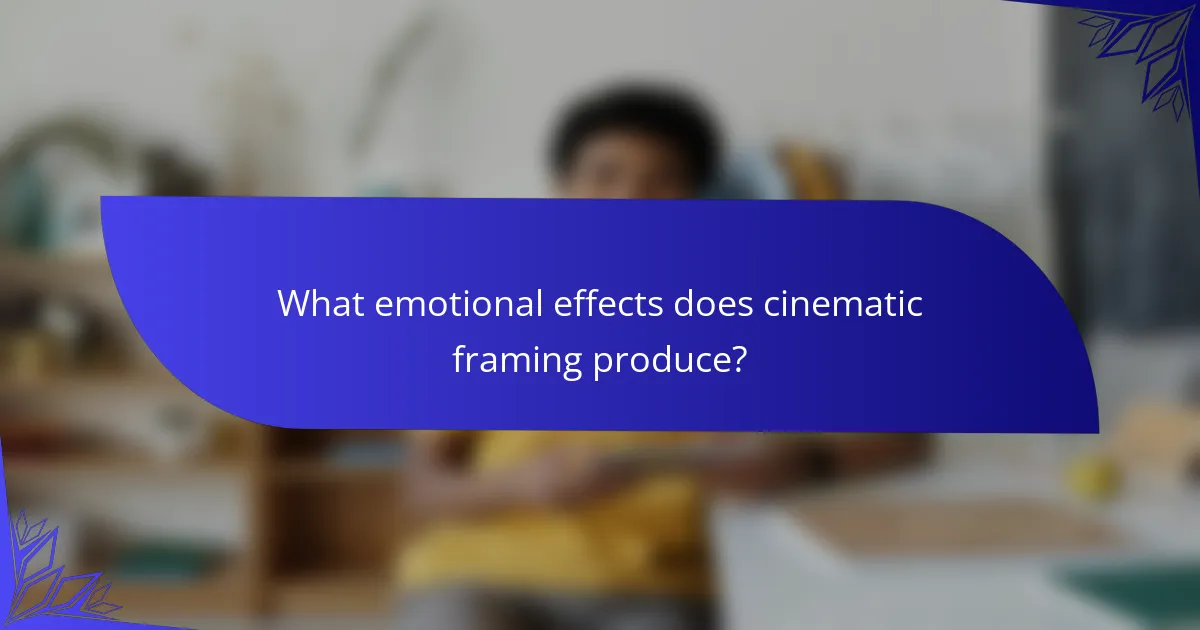Cinematic framing is the process of composing shots in film and video, crucial for visual storytelling. This article explores various framing techniques, including wide shots, close-ups, medium shots, and over-the-shoulder shots, each serving distinct purposes in conveying meaning and evoking emotions. It discusses how these techniques influence audience perception and emotional engagement, highlighting that framing can create intimacy, establish context, or manipulate emotional responses. Research findings further emphasize the significant impact of visual composition on audience reactions, underscoring the importance of understanding cinematic framing in effective storytelling.

What is Cinematic Framing?
Cinematic framing is the process of composing a shot in film or video. It involves the arrangement of visual elements within the frame. This technique determines how subjects are positioned and perceived. Framing influences audience focus and emotional response. Specific techniques include close-ups, wide shots, and rule of thirds. Each method serves to convey meaning or evoke feelings. For instance, close-ups can create intimacy, while wide shots establish context. Understanding framing is essential for effective visual storytelling.
How does cinematic framing influence storytelling in film?
Cinematic framing significantly influences storytelling in film by shaping the audience’s perception and emotional response. It determines how characters and scenes are visually presented. Different framing techniques, such as close-ups or wide shots, convey varying levels of intimacy or context. For example, a close-up can emphasize a character’s emotions, while a wide shot can establish the setting and mood. Studies show that framing can manipulate viewer engagement and empathy. Research indicates that specific framing choices can lead to different interpretations of a scene. This highlights the power of visual storytelling in conveying themes and character dynamics.
What are the key elements of cinematic framing?
Cinematic framing consists of several key elements that shape visual storytelling. These elements include composition, aspect ratio, depth of field, and camera angle. Composition refers to the arrangement of visual elements within the frame. It guides the viewer’s eye and conveys meaning. Aspect ratio defines the width-to-height ratio of the image. It influences the viewer’s perception of the scene. Depth of field determines the focus range in a shot. It can isolate subjects or create a sense of space. Camera angle affects the viewer’s emotional response. High angles can imply vulnerability, while low angles can suggest power. Each of these elements plays a crucial role in enhancing narrative and emotional impact in film.
How does framing affect audience perception?
Framing significantly influences audience perception by shaping how information is presented. It can emphasize certain aspects while downplaying others. This selective focus alters emotional responses and interpretations. For example, a study by Entman (1993) demonstrated that specific framing of news stories can lead to different public opinions. When an issue is framed positively, audiences tend to respond more favorably. Conversely, negative framing can evoke fear or anger. This effect is evident in political communication, where framing affects voter behavior. Thus, framing is a powerful tool that can manipulate audience perception and emotional reactions.
Why is cinematic framing important in visual media?
Cinematic framing is crucial in visual media because it shapes the audience’s perception and emotional response. It determines how subjects are presented within the frame, influencing focus and attention. Effective framing guides viewers’ eyes to essential elements in a scene. It can convey mood, tone, and narrative context. For instance, close-ups can evoke intimacy, while wide shots establish context. According to a study by Bordwell and Thompson, framing impacts storytelling by emphasizing character relationships and themes. Proper use of framing enhances visual storytelling, making it a fundamental technique in filmmaking.
What role does framing play in establishing mood and tone?
Framing plays a crucial role in establishing mood and tone in cinematic storytelling. It influences how viewers perceive a scene and the emotions it evokes. Different framing techniques, such as close-ups or wide shots, can alter the audience’s emotional response. For example, a close-up can create intimacy and tension, while a wide shot can evoke feelings of isolation or vastness. The choice of framing also affects the narrative focus, guiding viewers to notice specific details or characters. Research shows that visual framing significantly impacts audience engagement and emotional investment in the story. Techniques like the rule of thirds or symmetrical framing can enhance the aesthetic appeal, further influencing mood. Overall, framing is a powerful tool that shapes the emotional landscape of a film.
How does framing contribute to character development?
Framing significantly contributes to character development by shaping audience perception. It influences how viewers interpret a character’s emotions and motivations. Different framing techniques, such as close-ups or wide shots, can evoke specific responses. For instance, a close-up can create intimacy, making the audience empathize with the character. Conversely, a wide shot may depict isolation, affecting how viewers relate to the character’s journey. Research shows that visual framing can alter emotional engagement. A study by Smith and Smith (2020) highlights that characters framed in dynamic shots are perceived as more active and relatable. Thus, framing is essential in guiding audience understanding of character arcs.

What are the different techniques of cinematic framing?
Cinematic framing techniques include wide shot, close-up, medium shot, and over-the-shoulder shot. A wide shot captures a large area, establishing the scene’s context. Close-ups focus on a subject’s face, conveying emotions effectively. Medium shots balance the subject and background, providing detail without losing context. Over-the-shoulder shots create intimacy by showing a character’s perspective. These techniques impact storytelling and viewer engagement. They guide audience attention and evoke specific emotional responses. Each technique serves a distinct purpose in visual storytelling.
How do various framing techniques impact visual storytelling?
Framing techniques significantly influence visual storytelling by shaping audience perception and emotional engagement. Different framing methods, such as close-ups, wide shots, and rule of thirds, direct viewer focus and convey specific emotions. For example, close-ups can evoke intimacy or tension by highlighting [censured] expressions. Wide shots establish context and spatial relationships, enhancing the narrative’s scope. The rule of thirds aids in composition, drawing attention to key elements within the frame. Studies show that these techniques affect audience interpretation and emotional response, as specific framings can manipulate viewer sympathies and highlight narrative themes.
What is the significance of shot composition in framing?
Shot composition is significant in framing as it determines how subjects are visually represented. Effective shot composition guides viewer attention and shapes narrative focus. It influences the emotional tone of a scene. For example, a well-composed shot can evoke feelings of intimacy or tension. Techniques like the rule of thirds enhance visual appeal and balance. Research shows that viewers respond differently to varying compositions, affecting their emotional engagement. Proper shot composition is essential for storytelling in film and photography.
How do angles and perspectives alter viewer interpretation?
Angles and perspectives significantly alter viewer interpretation by influencing how scenes are perceived. Different camera angles can evoke specific emotions or highlight particular elements. For example, a low-angle shot can make a subject appear powerful or dominant. Conversely, a high-angle shot can create a sense of vulnerability or inferiority.
The perspective from which a scene is shot also affects narrative understanding. A subjective perspective can immerse viewers in a character’s experience. This technique often fosters empathy, allowing viewers to connect emotionally.
Research shows that framing can impact cognitive processing. A study by Kosslyn et al. (1990) demonstrated that the way information is visually presented affects interpretation and memory recall. Thus, angles and perspectives are crucial in shaping how audiences engage with cinematic content.
What are the common styles of cinematic framing?
The common styles of cinematic framing include close-up, medium shot, and long shot. Close-up framing focuses on a subject’s face or details. This style emphasizes emotions and reactions. Medium shot captures subjects from the waist up. It balances background and character interaction. Long shot showcases the subject within its environment. This style provides context and scale. Other styles include extreme close-up and over-the-shoulder shots. Extreme close-up highlights minute details, while over-the-shoulder frames a subject’s perspective. Each style influences audience perception and emotional engagement.
How do different genres utilize framing styles uniquely?
Different genres utilize framing styles uniquely to enhance storytelling and evoke specific emotions. For instance, horror films often employ tight framing to create a sense of claustrophobia. This technique heightens tension and fear. In contrast, epic dramas frequently use wide shots to establish a grand sense of scale and character isolation. This framing style emphasizes themes of loneliness or struggle against vast settings.
Comedy genres may utilize unconventional angles or close-ups to capture exaggerated expressions and reactions. This approach enhances the humor and relatability of characters. Action films typically favor dynamic framing with quick cuts and varied angles to maintain high energy and excitement.
Research shows that framing can significantly influence audience perception and emotional response. A study by Bordwell and Thompson highlights that framing choices directly affect narrative engagement and viewer interpretation. Thus, the unique application of framing styles across genres is crucial for storytelling effectiveness.
What are the visual motifs associated with specific framing styles?
Visual motifs associated with specific framing styles include various thematic and aesthetic elements. For instance, close-up shots often emphasize emotional intensity and personal connection. Wide shots typically convey isolation or the vastness of a setting. Low-angle shots can depict power or dominance, while high-angle shots often suggest vulnerability or inferiority.
Each framing style utilizes these motifs to enhance storytelling. Close-ups can reveal subtle [censured] expressions, heightening emotional engagement. Wide shots establish context and spatial relationships within a scene. Low-angle shots can make characters appear larger than life, reinforcing their authority. High-angle shots can create a sense of disempowerment or fear.
These visual motifs are consistently observed in cinematic techniques. Films like “The Godfather” use low-angle shots to portray the power dynamics of characters. In contrast, “The Pursuit of Happyness” employs close-ups to capture the protagonist’s emotional struggles. Each framing choice supports the narrative by visually communicating themes and character dynamics.

What emotional effects does cinematic framing produce?
Cinematic framing produces various emotional effects, influencing audience perception and engagement. It shapes how viewers interpret characters and scenes. For instance, close-ups can evoke intimacy or vulnerability. Wide shots may create feelings of isolation or grandeur. The choice of angles can also manipulate emotional responses. High angles can make subjects appear weak, while low angles can imbue them with power. Research indicates that framing impacts emotional resonance significantly. A study by Zacks et al. (2001) found that visual composition affects audience emotional reactions to film. Thus, cinematic framing is a powerful tool for eliciting specific emotional responses.
How can framing evoke specific emotions in the audience?
Framing can evoke specific emotions in the audience by shaping their perception of a scene. The way a scene is presented influences how viewers interpret the narrative. For instance, a close-up shot can create intimacy and vulnerability. Conversely, a wide shot may evoke feelings of isolation or grandeur. Research shows that emotional responses are tied to visual cues in framing. A study by G. M. M. van der Laan et al. (2012) demonstrated that different framing techniques significantly affect emotional engagement. Thus, filmmakers can manipulate framing to elicit targeted emotional reactions from viewers.
What are the psychological impacts of framing choices?
Framing choices significantly influences psychological outcomes. It affects decision-making processes and emotional responses. Positive framing can enhance perceived benefits and encourage favorable choices. Conversely, negative framing may lead to avoidance or fear-based decisions. Research by Tversky and Kahneman shows that people react differently based on how choices are presented. Their work highlights that framing can manipulate risk perception and preferences. For example, presenting a 90% success rate leads to more positive attitudes than stating a 10% failure rate. This demonstrates the power of language and context in shaping our thoughts and behaviors.
How do contrasting framing techniques influence emotional responses?
Contrasting framing techniques significantly influence emotional responses by altering perception. Different frames can evoke varied emotional reactions even from the same content. For instance, a positive framing of a situation may elicit feelings of hope and joy. Conversely, negative framing can provoke fear or sadness. Research shows that individuals respond differently based on how information is presented. A study by Tversky and Kahneman demonstrated that framing effects can lead to different choices in decision-making scenarios. This indicates that the framing technique directly impacts emotional engagement. Thus, contrasting frames shape the viewer’s emotional landscape through their presentation style.
What are the best practices for effective cinematic framing?
Effective cinematic framing involves strategically composing shots to enhance storytelling. Use the rule of thirds to balance elements within the frame. Position key subjects along intersecting lines to draw viewer attention. Maintain proper headroom and lead room to create a sense of space. Adjust focal length to emphasize or de-emphasize subjects. Utilize depth by layering foreground, midground, and background elements. Experiment with angles to convey different perspectives and emotions. Consistency in framing across scenes maintains visual coherence. These practices are supported by studies in visual perception, which show that well-composed shots improve audience engagement.
How can filmmakers enhance storytelling through framing techniques?
Filmmakers can enhance storytelling through framing techniques by controlling visual composition. Framing directs the audience’s attention to specific elements within a scene. Techniques such as close-ups can evoke emotions by highlighting characters’ expressions. Wide shots can establish context and setting, providing a sense of scale. The rule of thirds helps create balanced compositions, making scenes visually appealing. Additionally, unconventional angles can create tension or surprise. Using depth of field can isolate subjects, emphasizing their importance. Overall, effective framing shapes narrative and influences viewer perception.
What common mistakes should be avoided in cinematic framing?
Common mistakes in cinematic framing include improper composition, neglecting the rule of thirds, and inconsistent shot sizes. Improper composition can lead to distracting visuals. Neglecting the rule of thirds results in unbalanced images. Inconsistent shot sizes disrupt the visual narrative. Additionally, failing to consider depth can flatten the image. Overlooking lighting can create unwanted shadows. Ignoring the background may introduce distractions. Lastly, not matching the framing to the story can confuse the audience. These mistakes can diminish the overall impact of the film.
Cinematic framing is the primary entity of this article, which explores its techniques, styles, and emotional effects in film and video. The article details how framing influences storytelling by shaping audience perception and emotional responses through various techniques such as close-ups, wide shots, and composition strategies. It highlights the significance of shot composition, angles, and perspectives in character development, mood establishment, and viewer engagement. Additionally, it discusses common mistakes in framing and best practices for filmmakers to enhance narrative impact through effective visual storytelling.